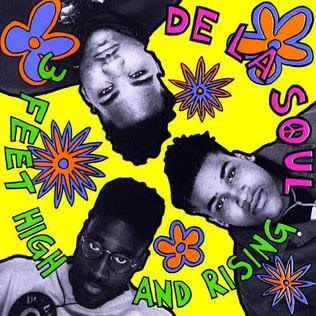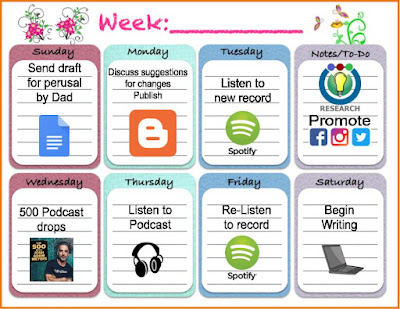I was inspired by a podcast called The 500 hosted by Los Angeles-based comedian Josh Adam Meyers. His goal, and mine, is to explore Rolling Stone Magazine's 2012 edition of The 500 Greatest Albums of All Time.
Album: # 349
Album Title: The Black Album
Artist: Jay Z
Genre: Hip-Hop
Recorded: 4 U.S. Studios (New York, Detroit, Los Angeles & Miami)
Released: November, 2003
My age at release: 38
How familiar was I with it before this week: One Song
Song I am putting on my Spotify Playlist: 99 Problems
On the Ontario Report Card for elementary students (Grade 1-8), the most important section is Learning Skills and Working Habits. In Growing Success, the 2010 document that outlines the policies and practises for educators to assess, evaluate and report on student progress in Ontario schools, six specific learning skills are identified: Responsibility, Organization, Independent Work, Initiative, Self-Regulation and Collaboration. For the past few years, I have been teaching Grade 7 students (12 to 13 year-olds). They are at the age where they can develop a deeper understanding of these learning skills and reflect on their strengths and challenges through a metacognitive lens. This involves working with them to write their own report card comments. For me, this means much less writing, but much more time discussing how best to assess each learner's triumphs and prepare strategies to improve their work habits. Among the questions I ask are two that almost always elicit the same responses. The first is, "Which of these learning skills do you think is the most important in our class, and for life?" The second is, "Which learning skill do you think is your best?"
I don't have documented data, but venture to say that, overwhelmingly, the answer to both questions is Collaboration. The responses thrill me because employment opportunities are increasingly prioritizing teamwork. The Google Workplace Model, which fosters creativity, flexibility and collaboration, is being adopted by companies in greater numbers. This is particularly true in the tech-sector, where many jobs can now be found. I thought a lot about collaboration as I listened to this week's record, The Black Album by Jay Z. It is the eighth studio record by the rapper, songwriter, record executive and entrepreneur who is widely regarded as one of the most influential hip-hop artists in history.
 |
| Jay Z with his wife Beyoncé |
The Black Album features almost 50 collaborators, including many big names from the world of entertainment, such as: Kanye West, Eminem, Cedric The Entertainer, John Legend, Timbaland, Rick Rubin and Pharrell Williams. Additionally, samples have been borrowed from multiple artists, including: Bill Haley and The Comets, Madonna, Wilson Pickett and Billy Squier. Rather than relying on a single producer, Jay Z recruited ten individuals or production teams. He even co-produced the song Threat alongside Patrick Denard Douthit, better known by his hip-hop pseudonym, 9th Wonder.  |
| Hip Hop Producer 9th Wonder |
There was a time when I didn't recognize the importance of the spirit of collaboration in the hip-hop recording community. I grew up as a fan of music that was written, performed and sometimes even produced by the members of the bands I loved. My favourite group growing up, Rush, comprised a trio that wrote and performed all of the music. For nine of their first ten records, they employed Terry Brown as their sole producer.  |
| Rush with producer Terry Brown (third from left) |
In 2015, fans of performer Beyoncé (who call themselves The Beehive), were outraged when the singer's fifth record, Beyoncé, failed to win the Grammy Award for Album of The Year. The honour was, instead, awarded to the record Morning Phase by Beck. Fans of Beck were quick to post the following graphic to social media threads, suggesting that the Beck record was superior because Morning Phase had been written and produced by Beck while Beyoncé had worked with more than 20 writers and producers, including her husband Shawn "Jay Z" Carter.
 |
| Social Media graphic comparing Beck's record with Beyonce's |
At the time of this controversy, I would have been on Team Beck. My mindset about record production prioritized individual creativity above collaboration. However, as my appreciation of the hip-hop genre has increased, mainly because of The 500, I better understand the importance of a collaborative spirit. After all, I encourage collaboration with my students daily. Why, then, wouldn't I tout Beyoncé’s record? -- An album which on the updated 2020 list is ranked #81. Beck's Morning Phase failed to chart.
The Black Album exhibits Jay Z's willingness to work with many artists to create a record that welcomes a variety of sounds and styles. It is, as Rolling Stone Magazine writer Joe Caramanica put it, "both old school and utterly modern. showcasing Jay Z's rapping talents at the top of their game."
My first exposure to the album came when the song 99 Problems was remixed by producer Danger Mouse for The Grey Album, a record that blended "a cappella" versions of Jay Z's raps with samples from The Beatles' 1968 self-titled record, often called The White Album -- A clever title given that elements from The Black Album blended with The White Album -- created The Grey Album. I was hooked. The aggressive and catchy lyrics from 99 Problems brilliantly fused with the raw and raunchy signature guitar riff from the song Helter Skelter. It's worth a listen.
I was hesitant to rhapsodize about this song for some time because of being troubled by the apparently disparaging chorus.
"If you're having girl problems I feel bad for you son,
I've got 99 problems and a bitch ain't one."
However, I recently learned (through The 500 Podcast episode with guest Neal Brennan) that "bitches" referred to police dogs. In his 2010 autobiography, Decoded, Jay Z maintained that the lyrics referenced a 1994 incident when he was pulled over by police. He refused to allow them to search his car. The police threatened to bring in police "drug" dogs to sniff the vehicle and, potentially, give them just cause for a search. However, the dogs never arrived and the threat proved to be an empty one.When I revisited verse two of 99 Problems, the narrative became obvious and the deeper commentary on the prevalence of racial profiling was crystal clear. "So I pull over to the side of the road
I heard, "Son, do you know why I'm stopping you for?"
‘Cause I'm young and I'm black and my hat's real low?
Do I look like a mind reader, sir? I don't know
Am I under arrest or should I guess some more?
"Well, you was doing 55 in a 54
License and registration and step out of the car
Are you carrying a weapon on you? I know a lot of you are."
So, a tip-of-the-hat to Jay Z and Beyoncé and their comfort with collaboration, as well as the guts to relinquish control of their art in the hopes of creating something even better. Clearly, with The Black Album, this was achieved.








































